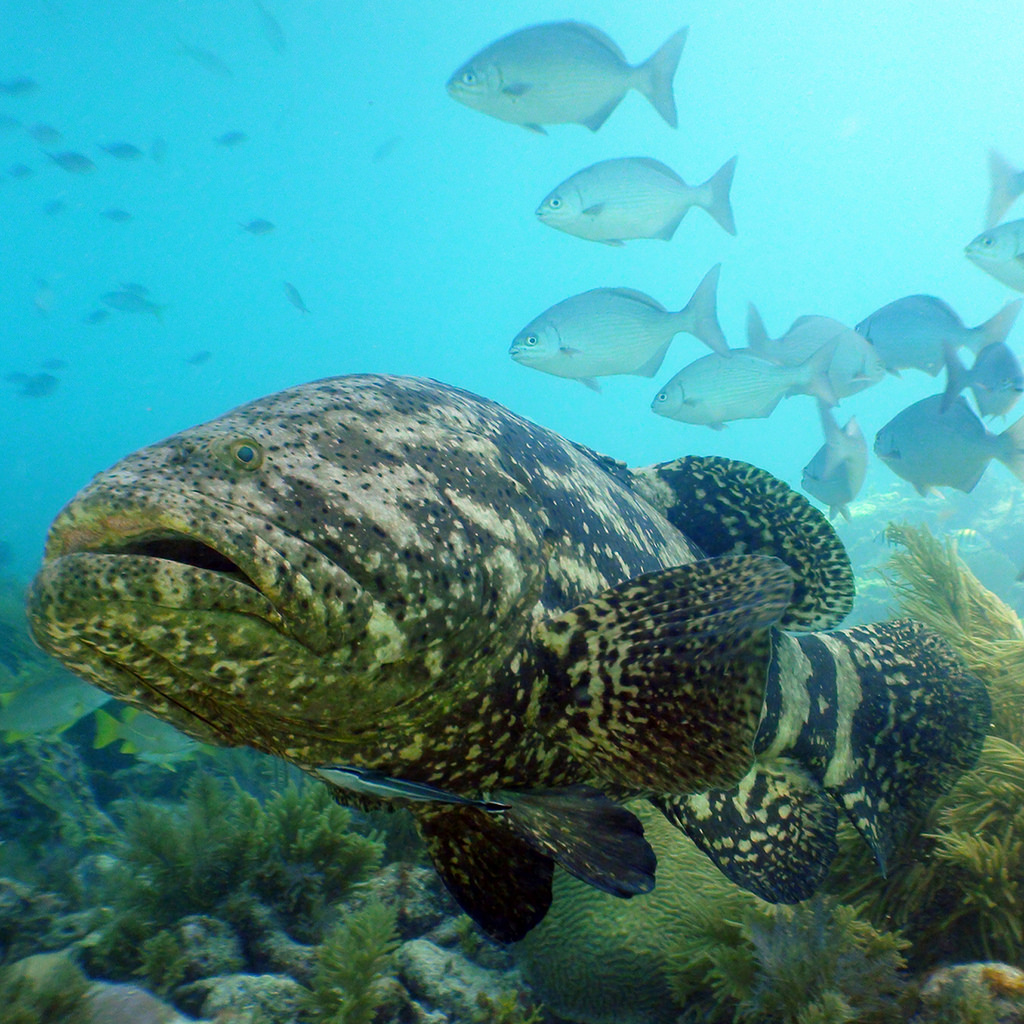
Goliath Grouper – Habitat, Diet, and Reproduction
Swimming through the stunning waters of the Florida Keys is always an amazing experience. What if during your next dive you came face-to-face with a 10-foot long, 700+ pound Goliath grouper? These gentle giants, also known as Epinephelus itajara, are a critically endangered species due to overfishing in the past. Today, the populations of these massive groupers are on an upswing due to dedicated educational programs and their inclusion in protected marine areas such as Florida Keys National Marine Sanctuary. Learn more about the Goliath grouper and its key role in the ocean ecosystem.
Meet the Goliath Grouper
Swimming up next to one of these giants, you will first be struck by the normalcy of their grouper “look” — albeit in a much larger size than you may have expected! Their skin is a mottled mix of greens, tans, and deep browns or black depending on their diet. Physically, the groupers average around 400 pounds and they have been recorded to live up to 37 years for males and 26 years for females. Groupers are generally a friendly species and can be found patrolling artificial and coral reefs alike, primarily in shallow tropical waters.
Habitat, Diet, and Reproduction
The Goliath grouper occurs in Atlantic waters from Florida to Brazil, including the Caribbean and Gulf of Mexico. It is also found in the eastern Atlantic from Senegal to Congo, and in the eastern Pacific from the Gulf of California in Mexico south to Peru.
Goliath groupers navigate to an annual spawning for breeding, the season and location varies depending on the population. In Florida, hatchlings join their brethren in safe spaces near coastal mangrove estuaries and spend their first six years of life dining exclusively on fish, crabs, and shrimp before heading out to open waters. The Goliath grouper grows slowly, attaining maturity around age 20-25, which is why it is important to manage fishing of the species; they need the chance to reach adulthood to reproduce in order to create a sustainable fishery.
The Goliath grouper is a key species in Florida waters because their presence is an indicator of health for local coral reefs. Reefs that are not healthy are unable to support large predators in any significant quantity.
The Goliath grouper requires significant food to grow. This particular species feeds by swallowing their prey whole, creating negative pressure that quickly them to bring in whole invertebrates, fish, and even smaller sharks. They are considered an “ambush predator”, and this apex predator prefers to roam through the reefs alone as opposed to swimming in packs.

Conservation and Management
One of the most recent threats to the Goliath grouper is not overfishing, but rather the presence of red tide events. Many grouper, manatees, and turtles were found washed ashore on Southwest Florida beaches during the red tides in 2003 and 2005. A combination of the large size of the fish, as well as the likelihood of overfishing and limited spawning, have combined to place the species on the IUCN’s critically endangered list, meaning that it is highly vulnerable to extinction. The good news is that as of 2006 the Goliath grouper’s population had improved and was considered to be on a recovery trajectory due to the careful protection by NOAA Fisheries.
Beautiful and fascinating, the Goliath grouper’s story is a tale of history — when fish were larger than life. While it may still be shocking to have one of these gentle giants join you on one of your underwater adventures, you have nothing to fear and plenty to learn!
